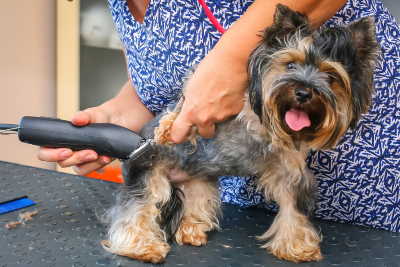- Small Dog Place Home
- Lifestyle
- Write an Essay About Your Dog
How To Write An Essay About Your Dog: Tips for an Excellent Essay
Write an Essay About Your Dog by Kenny Gill |Updated 10-18-2022
Your dog deserves an essay. You’ve got so many memories and so many anecdotes to tell. This is something not readily fleshed out and needs to be organized into a great and memorable essay. Here is how you can sort it out and impress your dog and your reader.
 How to Write an Essay About Your Dog
How to Write an Essay About Your DogSteps To Take to Write an Essay About Your Dog
Before You Write an Essay About Your Dog, You Must Truly Know Your Dog
You already know your dog. Don’t you? Think again. You might think you know your dog. There are, in fact, many details which, if missed, might make your dog just like any other.
For instance, you might believe some beautiful photos and a few stories are enough to make a great dog essay. This is not going to lead you anywhere. You might also have done some random online research.
That is, you might have looked up “essay on animals,” “writing essay about pets,” “animal essay,” and “essays about animals.” Or, if stuck, “great introductions for animal essay” and “what are the steps in writing an expository essay.”
This might be helpful, yet you’ll barely have enough information to get started. Instead, set everything aside and think about your dog. Beyond name and food, think about your dog’s unusual habits and unique incidents.
These quirks and idiosyncrasies are likely to help you know your dog in a different light. Often, such habits and incidents make great fodder for further development. Keep jotting down your memories and record any ones you notice. In so doing, your dog is set apart – even before writing – from all dogs you see or read about.
You might also want to note different moods your dog experiences. This is one great way to make your dog stand out using characterization. This will add sensory and visual details about your dog and will make your essay more vivid and your dog more real. If this all seems overwhelming, some people choose essay writing services online to help them.
In contrast, choosing to simply list descriptions about your dog in your pre-writing phase is hardly exciting. You should know your dog better than that. Just remember you’re still in an early phase of your essay writing process. So, just note as many memories and record just as many incidents before you start writing.
This is extremely important since collecting material should be informed by how you believe you should talk about your dog.

Collect Material from Primary and Secondary Sources Before You Write an Essay About Your Dog
So, having framed your dog, you need to back up. True, you’re writing about your own dog. However, you need to back up and inform your writing by serious research. This should include primary and secondary sources. Obviously, your primary sources are your personal photos and notes you’ve of your dog. This is the material you use to make your essay stand out and your dog unique.
In addition, you should use secondary sources to back up your observations about your dog. This is, basically, research materiel about pets and animal behavior in general.
In collecting secondary sources, just make sure you use credible sources. You don’t want to use sources intended for different breeds nor ones aimed at different readers.
The importance of research for your essay cannot be over emphasized. For one, you make your essay more credible and, ultimately, more readable and shareable. More, research is an eye-opener for you.
Indeed, you might have had your own beliefs about dogs and animal behavior in general. Doing proper research helps you not only write a great essay but also changes how you handle your dog. Tips on doing research about animal behavior and dog habits can be found at https://essaykitchen.net/admission-essay/
Create an Outline
Framing your dog and collecting material are the first essential steps in writing your essay. Next you need a structure, a form, or a shape to your essay. This can be done only by creating an outline.
Specifically, try out prompts. This means that you will start by narrowing down your material into a list of short points. This should enable you to arrange your ideas and content into different headings and subheadings. As you proceed, you’ll notice your essay is now taking shape, or developing structure, exactly what you need to expand on writing your first draft.
The importance of creating an outline cannot be overemphasized. Think of a blank paper or screen you’re staring at, ready to write your essay. You could jot down a few sentences, but, at some point, you’ll run out of thoughts.
In contrast, outlines help you keep on track and, more importantly, be more organized. Of course, you could tweak your outline a bit (but not too much).
However, you should stick to your outline as much as possible, unless you’ve stumbled upon a really great idea. In that case, you may decide that changing your outline will make your essay even better. In any case, just make sure your outline is short and well structured, so your words flow.
Write Your First Draft
This is where most people trip. Understandably, writing is exacting enough for pros, let alone novices. That’s why you need to get started and revise your work later.
Often, many people spend hours and hours, if not days, crafting an introduction to an essay. If you do, you’re going to be writing forever.
(Also, forget about gaining followers and trying to make your dog famous.)
Instead, just get down to business and start writing. There is no such thing as a perfect first draft or even an ideal final essay. There is always room for change and improvement. So, just start writing according to your outline. Once done, you can set your essay aside to keep a distance for a first revision.
Revise and Proofread
That you shouldn’t spend forever on your essay doesn’t mean you shouldn’t revise or proofread your article. Never ever turn your essay in unless you check for errors.
Nothing really pisses off instructors or readers than having silly mistakes. Pay particular attention to mistakes you might have done in your introduction. These are mistakes that stand out and are most likely to drive readers away. So, make sure your introduction is well written and error-free.
Then, go over your essay line by line. You may also find that reading your essay out loud helps you find other mistakes you might have made. This helps you identify any awkward sentences or structures. If spotted, change them. Keep reading and revising.
This is a repetitive process. If necessary, reach out for a friend’s or even a professional’s help. For an excellent revision and proofreading service, check essaywritingservice.ca.
Wrap Up: Write an Essay About Your Dog
Make sure you know your dog so you can write a great essay about him. Collect material. Take notes and record new incidents. Create an outline to give your essay a structure. Write your first draft, and don’t spend so much time crafting each and every sentence. This is a draft. Once done, revise and proofread and, if necessary, reach out for a friend’s help or a professional service. For an excellent revision and proofreading service, check essaywritingservice.ca
Author Bio (How to Write an Essay About Your Dog
Kenny Gill is a senior advisor and writer in the department of customessayorder.com.
He is familiar with corporate events, sports, education. He is responsible for supporting internal communications needs for specific business functions, as well as writing, creating, and editing various quality content. He performs a leading role in developing and creating good content, chiefly for different types of audiences.
Pin for Future Reference
Did You Find this Article, How to Write an Essay About Your Dog?
About Janice (author and voice behind this site)
Having lived with dogs and cats most of her life, Janice served as a veterinary technician for ten years in Maryland and twelve years as a Shih Tzu dog breeder in Ohio.
Her education includes undergraduate degrees in Psychology with a minor in biology, Early Childhood Education, and Nursing, and a master's in Mental Health Counseling.
She is a lifelong learner, a dog lover, and passionate about the welfare of animals. Her favorite breed for over 50 years has been the Shih Tzu, but she has also lived with Poodles, Maltese, Yorkshire Terriers, Beagles, English Bulldogs, Carin Terriers, and a Cocker Spaniel.
When not writing, reading, and researching dog-related topics, she likes to spend time with her eight Shih Tzu dogs, husband, and family, as well as knitting and crocheting. She is also the voice behind Miracle Shih Tzu and Smart-Knit-Crocheting
Does This Article Deserve Your Thumbs Up?
We always appreciate your support and encouragement. Your thumbs up means so much to us. Please like this article.
If you find this page or any page on Small Dog Place Helpful, or useful in anyway, I'd love it if you would click the small heart found on the bottom right of each page.
You can also share or bookmark this page -- just click on the:

Free Monthly Newsletter
Sign Up for Our Free Newsletter and get our Free Gift to You.
my E-book, The Top 10 Mistakes People Make When Choosing a Dog (and how to avoid them)









